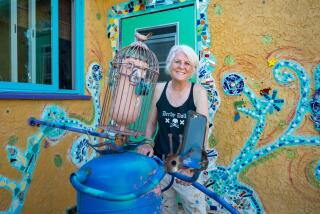‘When I look back at the statues, it was just one of the most beautiful parts of my life.’
- Share via
Some called Ali Roushan’s towering metal works art, others called them blight. But the Costa Mesa Planning Department called them illegal.
It’s been seven years since the Costa Mesa welder began stirring controversy with a towering abstract sculpture built as “a tribute to the human spirit.” Local fame followed with a series of four sculptures on his Superior Avenue property that generated two years of publicized court battles.
The passionate metalworker shouted obscenities in the courtroom, meditated on the platform of his 30-foot-plus tower sculpture and tenaciously held that he had a First Amendment right to freely “express his views in a rigid art form.”
City officials saw it differently. The Roushan structures soared to more than 60 feet in a town where height requirements allow just 30 feet. In addition, the structures failed to complement renewal plans for nearby development.
Roushan served five days in jail for contempt of court in September, 1982. By February, 1983, the weary maverick took a crane to his works and dismantled his “framework of peace and love.”
The legal wrangling that consumed his time and money also cost him his custom welding business, his third marriage and his Costa Mesa house. Poor health--caused, he says, by his refusal to wear protective gear while he worked--was aggravated, so he leased a portion of his industrial property for a restaurant and bar and planned to recuperate while traveling the country in a converted bus.
The 1967 Greyhound bus now sits in the former welding shop parking lot. “I still fire it up once in a while,” he says, but the trip never got off the ground.
He says the domino effect that began during “the statue thing” has continued to take a toll. Roushan, an Iranian immigrant who came to America in 1963 because “I figured this is supposed to be the core of democracy,” said he is contemplating a way to “start over.”
Roushan says his business ventures since he razed his sculptures have been difficultand often bitter, leaving him more experienced and realistic in his thinking. The sculpture project may have been costly, but he envies the energy and innocence he once had to take on the world.
“The energy was great, it created controversy, it motivated a lot of people. A lot of people got involved. When I look back at the statues, it was just one of the most beautiful parts of my life.”
He said the Iranian hostage crisis in 1980-81 stimulated him to promote peace between individuals where governments had failed. The sculptures were his expression of that desire.
“I just wanted to focus energy to a point to deter from riots, hatred and violence. It worked out, because it brought attention and intellectual controversy. It was not a waste. I had a duty.”
At age 44, Roushan says, he is finally “growing up.” And, after 25 years in the United States, the father of two says he wants to become a U.S. citizen.
He still has a dream: the building of a giant quill several hundred feet tall, demonstrating the power of the written word. And though he says he hasn’t given up, Roushan says the dream is waning in the face of financial woes.
“I would need outside financial help. I would like to get involved with a government institution--which would be the ultimate dream--to bring the closeness of the government and the renegade. If I did it again, I would need City Hall and the cooperation of people. My intentions are good.”
In the meantime, Roushan is thinking about opening a craft shop with a trusted friend who works in marble. He wants to make metal sculptures. Small ones.
More to Read
Sign up for Essential California
The most important California stories and recommendations in your inbox every morning.
You may occasionally receive promotional content from the Los Angeles Times.













